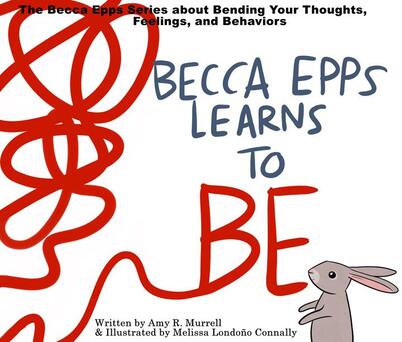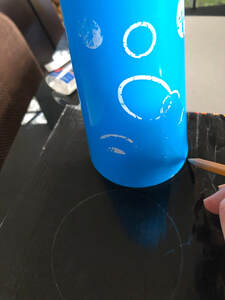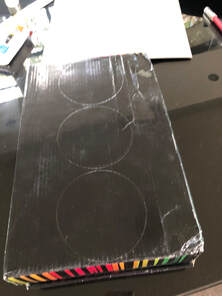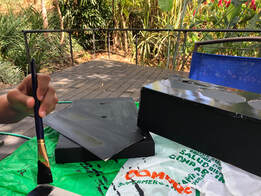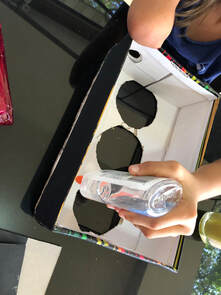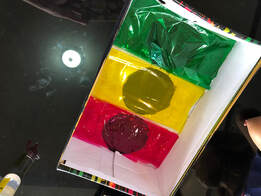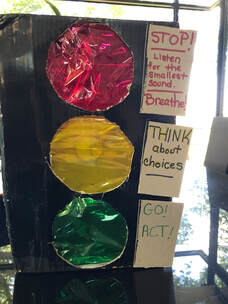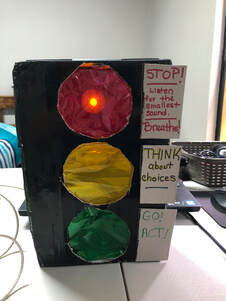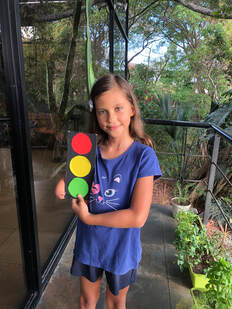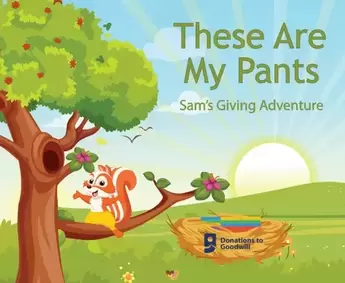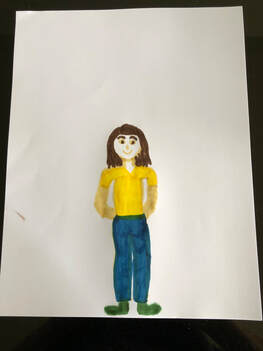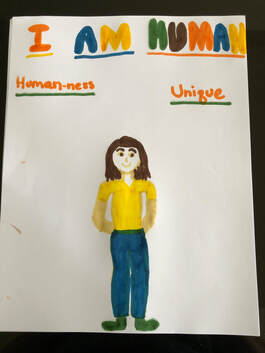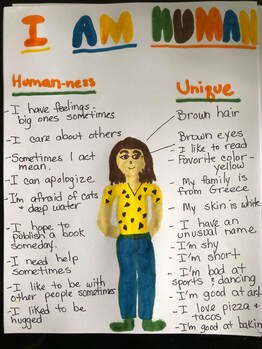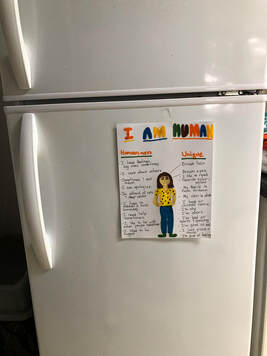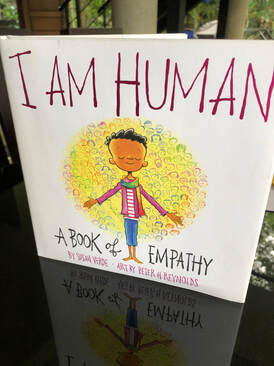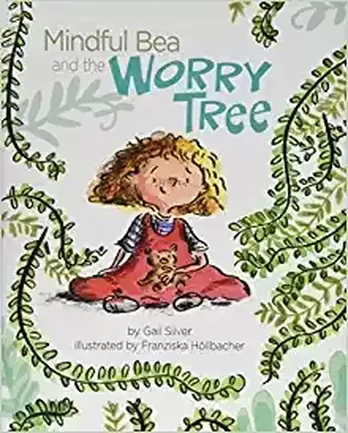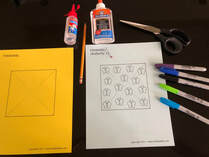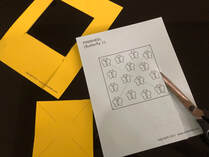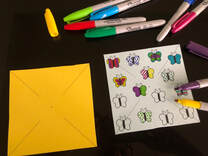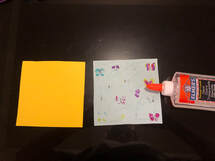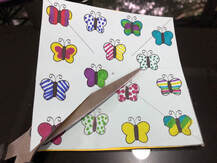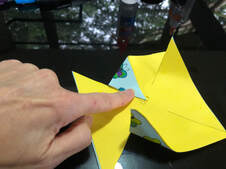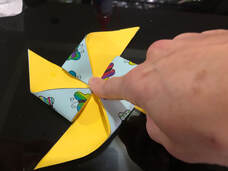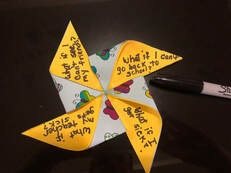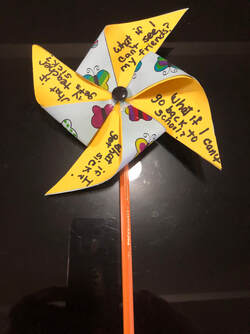A Book Review of Becca Epps Learns to Be
Becca Epps Learns to Be focuses on behavioral issues typically associated with Attention Deficit Hyperactivity Disorder (ADHD), however, the issues and behaviors within the story can relate to all children at one time or another. Children struggling with ADHD types of issues will surely relate to Becca. Through Becca, the author clearly captures the workings of the ADHD mind, with the tendency to act on impulse, daydream and become overwhelmed easily. Despite these issues, Becca is presented as a likeable character with her spirited personality shining through. This book is packed chock full of coping strategies, which are part of the ACT therapeutic process. The coping strategies presented relate to mindfulness and can benefit all children, and adults alike. The first strategy demonstrated is one that I've used often in my practice and find very helpful. It is the stoplight strategy, which is a great visual self-control tool to assist kids in slowing down to think before they act. Many strategies for focusing on the moment and paying attention to your body are modeled by Becca and presented in a child-friendly way. The book realistically addresses the difficulty in focusing your mind on these strategies and carrying them through. The illustrator, Melissa Londoño Connally, captures Becca's spirit and energy throughout the book. Becca is depicted as a character in the older age ranges of a picture book. Therefore, this book can be used therapeutically for a broader age group ranging from 4 to 11 years old. Ms. Murrell provides a wealth of helpful information at the end of the book, including a note to adults, discussion questions and further activity ideas. This book will be a very helpful addition to your therapeutic, home or classroom library. Check it out and purchase here, along with other helpful books in the Becca Epps series. ***I have an exciting announcement this month! I am going to feature, Amy Murrell, the author of this book, in an interview at the end of the month! She has reviewed research extensively on the benefits of bibliotherapy and will share with us her findings, as well as share more about her book series. Check back at the end of the month for this exciting and informative interview!*** I have provided an activity idea below based on the stoplight self-control strategy presented in the book. Activity Idea for Becca Epps Learns to BeThe most important activity to go along with this book is to practice the mindfulness exercises presented. If you practice these skills with the child often when they are calm and attentive, they are more likely to use them at times when they are most needed. Make these strategies a part of your routine! Materials needed: -shoe box -cardboard or heavy paper -black paint -glass to trace circles -Sharp scissors - X-acto knife -strong glue -Cellophane in red, yellow and green(or tissue paper can work) -flameless tealight candles -3 ***I got a little over-excited and extravagant with this project! You could also simply use a piece of cardboard, glue on 3 circles cut from construction paper for the lights and move on from there! This might work much better for the younger kids.
2 Comments
A Book Review of |
| I Am Human A Book of Empathy Written By: Susan Verde Illustrated By: Peter H. Reynolds Published By: Abrams Books for Young Readers Recognizing our connection to each other through our humanity and empathizing with the plight of others is key to making this world a better place. I Am Human introduces these concepts to the youngest among us. It has become clear through this pandemic and the Black Lives Matter movement that our culture is lacking empathy and the ability to put ourselves in someone else's shoes. Teaching our children the importance of human connection, acceptance and empathy towards others will go a long way in improving our culture. The ability to care about the impact of our actions and behaviors on others is crucial. |
I Am Human sends an important message to all of us, but is most appropriate for children ages 3-8. Susan Verde skillfully weaves many layers into this simple book.
The larger take away is that we are all human. This sounds obvious, but the reality in this world is that is not how we treat each other. We are all human regardless of the color of our skin, different abilities, the country we are from, our religion or if we are from a poorer or richer part of town. We are all connected by our human-ness and are all unique in our own way. This book celebrates the human potential of feeling empathy and compassion toward ourselves and others.
The smaller messages relate to the fact that the human condition is imperfect. We all have our strengths and weaknesses and we should respect those things in ourselves and others. I Am Human is a hopeful book in that it portrays the journey of being human as having challenges and possibilities. We all have feelings that we express in different ways. Part of being human is being afraid of things sometimes or feeling sad occasionally or hurt or angry about something somebody said to you. We have the ability to make choices. We can apologize for our mistakes and try to do better. We can choose to be helpful to others if they are struggling or kind to ourselves.
The art by Peter H. Reynolds is simple, yet beautiful. It shows the connection between others and hopefulness of the human condition. The book includes a Loving/Kindness Meditation at the end.
I recommend this book for all children to teach them these human ideals from a young age and give them the reassurance and knowledge that they are part of something bigger and are not alone. It reinforces a sense of community that will help all of us get through difficult times. You can find this book and others in the I AM Series by Susan Verde and Peter H. Reynolds on her website at https://www.susanverde.com/susans-books.
As an example of showing empathy toward others, I recommend this follow up book that reinforces the joy of helping others.
The larger take away is that we are all human. This sounds obvious, but the reality in this world is that is not how we treat each other. We are all human regardless of the color of our skin, different abilities, the country we are from, our religion or if we are from a poorer or richer part of town. We are all connected by our human-ness and are all unique in our own way. This book celebrates the human potential of feeling empathy and compassion toward ourselves and others.
The smaller messages relate to the fact that the human condition is imperfect. We all have our strengths and weaknesses and we should respect those things in ourselves and others. I Am Human is a hopeful book in that it portrays the journey of being human as having challenges and possibilities. We all have feelings that we express in different ways. Part of being human is being afraid of things sometimes or feeling sad occasionally or hurt or angry about something somebody said to you. We have the ability to make choices. We can apologize for our mistakes and try to do better. We can choose to be helpful to others if they are struggling or kind to ourselves.
The art by Peter H. Reynolds is simple, yet beautiful. It shows the connection between others and hopefulness of the human condition. The book includes a Loving/Kindness Meditation at the end.
I recommend this book for all children to teach them these human ideals from a young age and give them the reassurance and knowledge that they are part of something bigger and are not alone. It reinforces a sense of community that will help all of us get through difficult times. You can find this book and others in the I AM Series by Susan Verde and Peter H. Reynolds on her website at https://www.susanverde.com/susans-books.
As an example of showing empathy toward others, I recommend this follow up book that reinforces the joy of helping others.
| These Are My Pants Written by: Jane and Katelyn Plank Ilustrated by; Aniqa Ashfaq This is a self-published book, that is not only about the virtue of giving to others, but also sets an example for giving as a portion of the book proceeds go towards Goodwill. I encourage you to purchase this book and use it as an example of being human and showing empathy toward others. |
Reading These Are My Pants provides an excellent opportunity to put the concept into action and have your child participate in an act of giving to others. It could be something of theirs that they are willing to give up to help others, something new that you buy together, or a service that the child can provide in the mission to help another human. Share the joy of giving with your child!
To learn more about These Are My Pants and to purchase the book, go to their website at https://www.plankbooks.com/.
To learn more about These Are My Pants and to purchase the book, go to their website at https://www.plankbooks.com/.
Activity Idea for I Am Human A Book Of Empathy
We are all connected with our human-ness, even though we are all unique in many ways. My suggestion is to pose two questions to your child after reading the book.
What makes you human?
What makes you unique?
Use those ideas to complete the following activity.
Materials needed:
8.5 x 11 paper or a roll of paper cut to the size of the child
markers or crayons
pencil
Directions:
If you have a roll of paper that you could have the child lay on and trace them, this would be the funnest way to continue. I don't have a paper roll or a child with me, so I will draw the child on a regular size paper. Either way is fine.
What makes you human?
What makes you unique?
Use those ideas to complete the following activity.
Materials needed:
8.5 x 11 paper or a roll of paper cut to the size of the child
markers or crayons
pencil
Directions:
If you have a roll of paper that you could have the child lay on and trace them, this would be the funnest way to continue. I don't have a paper roll or a child with me, so I will draw the child on a regular size paper. Either way is fine.
| 1. Have child lay on the paper on his/her back and trace around their body with a pencil. Then have child draw on and color their hair, eyes, clothes, etc. Or draw child outline on sheet of paper and have them color in details of themselves. Encourage them to make it look like their unique selves with hair color, skin color, eye color etc. Make sure to leave room around the drawing for writing. 2. Write I AM HUMAN at the top of the page and label one side with human-ness and the other, unique. 2. Around the portrait of themselves, discuss and write the things that make them both human and unique. The photo shows some examples. 3. Hang completed project on refrigerator or wall so they can see often. 4. Share with the child how you are different and the same as them. Have fun! |
A Book Review of Mindful Bea and the Worry Tree
| Mindful Bea and the Worry Tree Written by: Gail Silver Illustrated by: Franziska Hollbacher Published by: Magination Press I chose Mindful bea and the Worry Tree to review this month as I think all of us have been feeling some level of anxiety about the pandemic and are worried about what the future will bring. The most pressing worry as we are approaching August for children, parents and teachers is whether or not they will return to school in person this Fall. If so, what will that look like? Will it be safe? What happens if I get sick? What if I don't return to school? What will online learning be like with a new teacher? So many important questions and so few answers. Anxiety and worry are a normal reaction to these current circumstances. |
Pandemic panic aside, anxiety disorders are the most common psychological issue among children. Anxiety has been on the rise in our society for many years. Anxiety and worry are a normal part of childhood, but it can become more severe in some children. This book, Mindful Bea and the Worry Tree, is excellent for children within the whole spectrum of anxiety, from everyday worries to severe disturbances. This book will help children name and understand their feelings of anxiety as well as learn to cope with it.
The author, Gail Silver, utilizes a tree as an analogy for anxiety, with beautiful writing as follows:
"like a seed from underground, it sprouts alive, unleashed, unbound. With knarled roots, this kind of tree feeds on thoughts ..." The story begins as Bea, in anticipation of her birthday party, is bombarded with thoughts of "What if ..." "What if nobody comes? What if we didn't bake enough cake?" These "what if ..." questions are very common in all of our thoughts when anxiety starts to take hold.
Through Bea, Ms. Silver does a thorough job in describing the physical sensations in our bodies when we are feeling anxious. This is an important step in helping children recognize and name their feelings, which is crucial to coping. She then takes children through a meditation process, including deep breathing and slowing down thoughts in order to choose what to think about. Repetition of words is used in the text to show Bea slowly calming herself down and quieting her irrational thoughts as she is employing her coping skills.
Franziska Hollbacher, the illustrator, follows the mood of the story beautifully through her illustrations. Initially the vines of the tree are taking over. Slowly these vines recede and the illustrations become more and more calm and then full of fun energy as the birthday party begins.
This book includes a Note to Parents, written by a psychologist, which includes helpful information on how to use this book, information on understanding anxiety in children, how parents can help, and when to seek professional help.
I strongly recommend this book for all children ages 4-8, whether struggling with temporary, everyday worries or with an ongoing anxiety disorder. Check out other books on emotions by Gail Silver at https://gailsilver.com/books-and-more/.
I have included additional resources below and an activity to further help your child with their worries and anxieties.
The author, Gail Silver, utilizes a tree as an analogy for anxiety, with beautiful writing as follows:
"like a seed from underground, it sprouts alive, unleashed, unbound. With knarled roots, this kind of tree feeds on thoughts ..." The story begins as Bea, in anticipation of her birthday party, is bombarded with thoughts of "What if ..." "What if nobody comes? What if we didn't bake enough cake?" These "what if ..." questions are very common in all of our thoughts when anxiety starts to take hold.
Through Bea, Ms. Silver does a thorough job in describing the physical sensations in our bodies when we are feeling anxious. This is an important step in helping children recognize and name their feelings, which is crucial to coping. She then takes children through a meditation process, including deep breathing and slowing down thoughts in order to choose what to think about. Repetition of words is used in the text to show Bea slowly calming herself down and quieting her irrational thoughts as she is employing her coping skills.
Franziska Hollbacher, the illustrator, follows the mood of the story beautifully through her illustrations. Initially the vines of the tree are taking over. Slowly these vines recede and the illustrations become more and more calm and then full of fun energy as the birthday party begins.
This book includes a Note to Parents, written by a psychologist, which includes helpful information on how to use this book, information on understanding anxiety in children, how parents can help, and when to seek professional help.
I strongly recommend this book for all children ages 4-8, whether struggling with temporary, everyday worries or with an ongoing anxiety disorder. Check out other books on emotions by Gail Silver at https://gailsilver.com/books-and-more/.
I have included additional resources below and an activity to further help your child with their worries and anxieties.
Activity and Resources for Mindful Bea and the Worry Tree
Belly breathing is the most important skill to acquire and not easy to teach young children - here are a couple of links to videos to help teach belly breathing to kids
https://www.youtube.com/watch?v=VOnDA6_MAWI
https://www.youtube.com/watch?
Relaxation/Meditation/Mindfulness - an abundance of apps are available on Iphone or Ipad with meditation/mindfulness exercises for kids. A few of the higher rated apps are:
Stop, Breathe and Think Kids
Breathe, Think, Do with Sesame Street (for the younger crowd)
Calm (has a specialized kid's section)
https://www.youtube.com/watch?v=VOnDA6_MAWI
https://www.youtube.com/watch?
Relaxation/Meditation/Mindfulness - an abundance of apps are available on Iphone or Ipad with meditation/mindfulness exercises for kids. A few of the higher rated apps are:
Stop, Breathe and Think Kids
Breathe, Think, Do with Sesame Street (for the younger crowd)
Calm (has a specialized kid's section)
Activity
Materials needed:
pinwheel template https://www.firstpalette.com/printable/pinwheel.html
Paper (cardstock works best)can use colored paper or white
unused pencil with eraser
push pin or tack
scissors
crayons or markers
black marker
glue -strong glue is helpful
bead or small button
Materials needed:
pinwheel template https://www.firstpalette.com/printable/pinwheel.html
Paper (cardstock works best)can use colored paper or white
unused pencil with eraser
push pin or tack
scissors
crayons or markers
black marker
glue -strong glue is helpful
bead or small button
| Directions: I suggest that you make two-one for child and one for adult helper 1. Talk to child about their worries, write them down and set aside for now 2. Share a couple of your minor worries as an adult without overwhelming the child 3. Print out 2 templates(one plain and one with desired design) for each pinwheel on cardstock or paper 4. Cut out squares 5. Color designs on one square as desired 6. Glue un-decorated sides of the squares together 7. Cut inside of squares along dotted lines 8. Bring every other tip of each of the sides to the center without folding paper; Glue in place; Hold in place until dry; Trickiest part-need strong glue 9. Pull out the list of child's worries and write on the solid parts of the pinwheel with a black marker 10. Insert push pin through center where tips come together; wiggle it around to make the hole a little bigger 10. Add bead or button to pin on the back side of pinwheel 11. Insert push pin into the eraser of the pencil; make sure it's not poking out the other side of the eraser. 12. Blow on it to make sure it twirls freely; if not, loosen the pin and wiggle it around more; works best if you blow toward the front of the pinwheel and not the sides 13. Blow those worries away and make the pinwheel spin! Adult should breathe with them with their pinwheel. 14. Pull the pinwheel out when child is having worries. Have fun! |
A Book Review of Being Bree
Bree and the Nametag Worries
| Being Bree Bree and the Nametag Worries Written by Christine Sromek Laforet Illustrations by Lisa Rush Publisher: Clear Fork Publishing This month I'm moving into a slightly older age-group and reviewing a Chapter Book/Early Reader appropriate for ages 6-10. Through this book, Christine Laforet covers a lot of ground. Besides simply being an enjoyable read for a youngster, this book addresses a host of childhood issues, especially related to the school experience. I highly recommend this book for all children within this age range. |
Although the main focus of this book is anxiety, it addresses the ancillary problems associated with academic giftedness. Additionally, Ms. Laforet touches on issues of making friends, social skills, experiencing intense feelings, impulsive behaviors and issues with self-control. Therefore, it is appropriate for a wide range of children. It is also a helpful read to increase empathy for children who do not experience these particular problems. Incorporated within the story, Ms. Laforet presents many age-appropriate coping strategies that are useful for all children, as well as adults. This book is up-to-the-minute regarding experiences of kids in today's world, i.e. cell phones and video chats. She uses humor throughout the book that makes it fun to read.
Bree is a bright, academically gifted girl with a propensity for anxiety. Her thoughts tend to run wild when she is faced with situations that are difficult for her. The plot of the book revolves around a school project for the first day of school, in which Bree is required to create a nametag showing her interests. This activity raises her anxiety about making friends as she begins to think about the upcoming school year. Bree tends to have poor boundaries with peers and can be annoying to others as she tries too hard to fit in. Based on these issues, Bree remembers how she has had difficulty fitting in with peers and the "What if..." questions start to take over her thinking.
Throughout the story, Bree experiences many failures related to making friends which further heightens her anxiety. She loses her nametag and is forced to make friends without it, a feat Bree thinks is impossible. She models for the reader strategies for calming herself down and controlling her emotions. Ms Laforet weaves these strategies into the story well so that they do not appear preachy. By the end of the book, Bree has learned some social lessons and does make friends.
Ms. Laforet does an excellent job opening the door to Bree's thoughts and feelings, allowing the reader to empathize with her. Through the illustrations, Lisa Rush creatively brings Bree's spunky and intense personality to life.
At the end of the book, Ms. Laforet lists the coping strategies modeled throughout the book. These include:
1. How to Take a Belly Breath
2. Steps to Calming Down
In the calming down steps, many strategies are mentioned including doing an action to distract from the thoughts, naming your feeling(s), counting, belly breathing, using positive self-talk.
Anxiety among children has become more prevalent over time and affects approximately 1 in 8 children ages 3-17. It is fairly common for children with anxiety to also experience behavioral problems and/or depression. For more severe forms of anxiety, therapy is recommended. Cognitive Behavioral Therapy can be especially helpful. Sometimes medication is necessary. For milder forms of anxiety, there are many strategies that can be used at home, in therapy, or in the classroom that can be especially helpful. Below is a list of activity ideas.
Being Bree: Bree and the Nametag Worries is the first book in the Being Bree series. Book 2 is currently available and Book 3 will be released soon. For more information, check out the author's website at www.christinesromeklaforet.com.
Bree is a bright, academically gifted girl with a propensity for anxiety. Her thoughts tend to run wild when she is faced with situations that are difficult for her. The plot of the book revolves around a school project for the first day of school, in which Bree is required to create a nametag showing her interests. This activity raises her anxiety about making friends as she begins to think about the upcoming school year. Bree tends to have poor boundaries with peers and can be annoying to others as she tries too hard to fit in. Based on these issues, Bree remembers how she has had difficulty fitting in with peers and the "What if..." questions start to take over her thinking.
Throughout the story, Bree experiences many failures related to making friends which further heightens her anxiety. She loses her nametag and is forced to make friends without it, a feat Bree thinks is impossible. She models for the reader strategies for calming herself down and controlling her emotions. Ms Laforet weaves these strategies into the story well so that they do not appear preachy. By the end of the book, Bree has learned some social lessons and does make friends.
Ms. Laforet does an excellent job opening the door to Bree's thoughts and feelings, allowing the reader to empathize with her. Through the illustrations, Lisa Rush creatively brings Bree's spunky and intense personality to life.
At the end of the book, Ms. Laforet lists the coping strategies modeled throughout the book. These include:
1. How to Take a Belly Breath
2. Steps to Calming Down
In the calming down steps, many strategies are mentioned including doing an action to distract from the thoughts, naming your feeling(s), counting, belly breathing, using positive self-talk.
Anxiety among children has become more prevalent over time and affects approximately 1 in 8 children ages 3-17. It is fairly common for children with anxiety to also experience behavioral problems and/or depression. For more severe forms of anxiety, therapy is recommended. Cognitive Behavioral Therapy can be especially helpful. Sometimes medication is necessary. For milder forms of anxiety, there are many strategies that can be used at home, in therapy, or in the classroom that can be especially helpful. Below is a list of activity ideas.
Being Bree: Bree and the Nametag Worries is the first book in the Being Bree series. Book 2 is currently available and Book 3 will be released soon. For more information, check out the author's website at www.christinesromeklaforet.com.
Activities Ideas for Being Bree
Bree and the Nametag Worries
All kids, like adults, feel worried and anxious from time to time. Sometimes, kids suffer from more chronic, severe anxiety that requires treatment. In addition to the strategies modeled in Being Bree, these activities can be helpful for all children to minimize anxiety and worries.
1. Belly breathing is the most important skill to acquire - here are a couple of links to videos to help teach belly breathing to kids
https://www.youtube.com/watch?v=VOnDA6_MAWI
https://www.youtube.com/watch?v=_mZbzDOpylA
2. Yoga - several DVDs are available for kid's yoga and many more kid's yoga classes are being offered in the community. A few of the higher rated DVDs are:
Storyland Yoga: Yoga for Kids and Families (ages 3-8)
Once Upon a Mat (ages 2.5+)
Yoga Motion (ages 2.5+)
3. Relaxation/Meditation/Mindfulness - an abundance of apps are available on Iphone or Ipad with meditation/mindfulness exercises for kids. A few of the higher rated apps are:
Stop, Breathe and Think Kids
Breathe, Think, Do with Sesame Street (for the younger crowd)
Calm (has a specialized kid's section)
Headspace (Has a specialized kid's section)
4. Exercise - rigorous exercise when the child is feeling anxious is very helpful
5. Journaling - if the child is old enough, writing out feelings and worries can be very therapeutic. "Get it out of your head and onto the paper" is one of my favorite lines for kids with many worries/anxieties.
- A very helpful journaling activity that I strongly recommend is to keep a small notepad and pen next to the child's bed. Before bed or anytime, the child can write their worries, feelings, or concerns that they want to share. The child gives the notepad to a parent in the morning and the parent, in turn, writes back to the child with reassuring statements or acknowledgement of feelings, etc. The parent then places the notepad next to the child's bed again before bedtime and the process is repeated daily or as often as possible. This not only helps the child 'get it out of their head and onto the paper', it helps the parent stay in touch with the feelings of their child. The writing practice doesn't hurt either!
Thanks for reading my blog. Feel free to leave me a comment below and let me know what you think.
1. Belly breathing is the most important skill to acquire - here are a couple of links to videos to help teach belly breathing to kids
https://www.youtube.com/watch?v=VOnDA6_MAWI
https://www.youtube.com/watch?v=_mZbzDOpylA
2. Yoga - several DVDs are available for kid's yoga and many more kid's yoga classes are being offered in the community. A few of the higher rated DVDs are:
Storyland Yoga: Yoga for Kids and Families (ages 3-8)
Once Upon a Mat (ages 2.5+)
Yoga Motion (ages 2.5+)
3. Relaxation/Meditation/Mindfulness - an abundance of apps are available on Iphone or Ipad with meditation/mindfulness exercises for kids. A few of the higher rated apps are:
Stop, Breathe and Think Kids
Breathe, Think, Do with Sesame Street (for the younger crowd)
Calm (has a specialized kid's section)
Headspace (Has a specialized kid's section)
4. Exercise - rigorous exercise when the child is feeling anxious is very helpful
5. Journaling - if the child is old enough, writing out feelings and worries can be very therapeutic. "Get it out of your head and onto the paper" is one of my favorite lines for kids with many worries/anxieties.
- A very helpful journaling activity that I strongly recommend is to keep a small notepad and pen next to the child's bed. Before bed or anytime, the child can write their worries, feelings, or concerns that they want to share. The child gives the notepad to a parent in the morning and the parent, in turn, writes back to the child with reassuring statements or acknowledgement of feelings, etc. The parent then places the notepad next to the child's bed again before bedtime and the process is repeated daily or as often as possible. This not only helps the child 'get it out of their head and onto the paper', it helps the parent stay in touch with the feelings of their child. The writing practice doesn't hurt either!
Thanks for reading my blog. Feel free to leave me a comment below and let me know what you think.
Follow me on Twitter, Pinterest and LinkedIn
Categories
All
Absent Dad
Acceptance & Commitment -Therapy Skills
Acceptance Of Others
ADHD
Adoption
Anger Management
Anxiety
Body Autonomy
Cognitive Behavioral Therapy Skills
Consent
Coping With ADHD
Coping With Depression
Coping With Feelings
Depression
Disability Awareness
Disappointment
Divorce
Domestic Violence
Empathy
Fear
Feelings General
Feelings-General
Foster Care
Gender Identity
Giftedness
Grandparents As Guardians
Grief & Loss
Growth Mindset
Incarcerated Parent
Kindness
Kinship Care
Learning Disabilities
Making Friends
Mindfulness
Negative Self Talk
Parental Anger
Parental Arguing
Parent W/Mental Illness
Parent W/Substance Abuse
Racial Injustice
School Lockdown Drills
Seizures
Self Esteem
Sensory Issues
Separation Anxiety
Sexual Abuse
Sexual Abuse Prevention
Shyness
Standing Up For Others
Suicide
Supporting A Friend
Temper Tantrums
Terminal Illness
Trauma
White Privilege
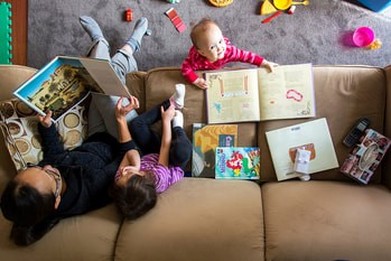
 RSS Feed
RSS Feed
